
Chinese Missionaries: Denominations

Figure 1.-- This is a magic lantern photographic slide showing the inside of a mission in China. You can tell by the way that the minister is dressed and the plauness of the room that this is a Protestant mission. You can see both men and boys, but no women and girls. There are, however, women in the hall to the right. We are not sure if this is a school room, chirch, or some other multiple-purose room. This was part of a selectiin of magic lattern slides of Chinese scenes from about 1880-1900. Missionaries took photographs like this and sent them home to the churches supporting them. They also used them in speaking tours.
|
|
The history of Christian missionaies is extensive and an important chapter of European history. The early phase of Catholic modern missiory work was dominated by the Catholic becaise the Portuguese and Spanish were the first to reach the East. Here the Society of Jesus (Jesuites) played a prominant role. The history of Catholic missionaries in China during the early phase of European contact it is a fascinating one. China at the time was not a poor, backward society, but in many ways richer and more technically advanced than Europe. The Jesuites were very active in China (15 and 16th centurues). They arrived in the fading years of the Ming Dynasty. Jesuit founder St. Francis Xavier attempted to reach China, but died before reaching the mainland (1552). Italian Jesuit Matteo Ricci led a group of Jesuits to China (1582). They and their sucesors introduced Western art, astronomy, math, and science to the Chinese Imperial Court.
They engged Confuscian scholars in philosophical debate. Eventually various emperors relied on Jesuits to serve in important posts. Some Comfuscian scholars adopted Chritianity, even vecoming Jesuits themselves. The Jesuits not only brought the Christian faith to Cina, but played a role in introducing Western science, and culture to China. Their work laid the foundation for Christianity in China. The Jesuits were not the only Christian missionaries, but until the 19th century went more Catholic and Protestant missionaries arrived, they seem by far the most influential. Gradually areaction to the Jesuits and Christians set in. Manchu Imperial authorities began to supress Christians (18th and early 19th centuries). Missionaries had to carry out their missionary work covertly.
The prominant Catholic missionary role in China did not change until the 19th century. Protestant missionaries were different from the Catholic missionaries in that they brought their families with them.
Sources
HBC

Related Style Pages in the Boys' Historical Web Site
[Long pants suits]
[Knicker suits]
[Short pants suits]
[Socks]
[Eton suits]
[Jacket and trousers]
[Blazer]
[School sandals]
[School smocks]
[Sailor suits]
[Pinafores]
[Long stockings]
Navigate the Boys' Historical Clothing Web Page
[Return to the Main Chinese missionary page]
[Return to the Main Chinese school page]
[Introduction]
[Activities]
[Biographies]
[Chronology]
[Clothing styles]
[Countries]
[Bibliographies]
[Contributions]
[FAQs]
[Glossaries]
[Images]
[Links]
[Registration]
[Tools]
[Boys' Clothing Home]
Created: 11:44 PM 8/23/2008
Last updated: 11:44 PM 8/23/2008




